What is diabetes?
“Diabetes is a condition that occurs when your body does not produce enough insulin or your body is not able to use the insulin produced effectively, resulting in blood glucose (blood sugar) levels being too high”. Blood glucose levels are measured in mg/dL or mmol/L.
There are two most common types of Diabetes:
- Type 1 Diabetes: Your body produces little to no insulin. Insulin must be taken each day to keep blood glucose levels in the normal range.
- Type 2 Diabetes: Your body makes insulin but it may not work properly or be enough to keep blood glucose levels in the normal range.
Nutrition
There is no such thing as a “diabetes diet.”There are plenty of food choices for you to consider and adjusting the types and amounts of food you eat will help you to control your blood glucose levels to live a healthier lifestyle.
Carbohydrates, protein and fat are the basic components found in different foods. All provide your body with the energy for use now and some is stored for use during periods when you are sleeping or meals are missed. A healthy diet includes a mixture all 3 of these. After eating, carbohydrates have the most noticeable impact on your blood glucose levels. Here is some basic information about carbohydrates:
What are Carbohydrates? Carbs are not one-size-fits-all
Carbohydrates (carbs) provide the calories and main source of energy for your body. Carbs are the sugars, starches, and fibers found in fruits, grains, vegetables, and milk products. Sugars and starches raise your blood glucose level, but fiber doesn’t. Carbs have the most impact on your blood glucose levels. But, not all carbs have the same effect on your blood glucose levels.
The Three types of carbs:
- Simple Carbs: Sugars, such as the natural sugar in fruit and milk or the added sugar in soda and many other packaged foods.
- Complex Carbs: Starches, including wheat, oats, and other grains; starchy vegetables such as corn and potatoes; and dried beans, lentils, and peas.
- Fiber: These include the part of plant foods that aren’t digested but are important to the digestive process and the elimination of waste products from your body.
What are Simple Carbohydrates?
Simple carbs are broken down quickly by the body to be used as energy. Simple carbohydrates are found naturally in foods such as fruits, milk, and milk products. They are also found in processed and refined sugars such as candy, table sugar, syrups, and soft drinks
Simple carbs are like quick-burning fuels. They break down fast into sugar in your system. Carbs , especially simple carbs, have the biggest impact on your blood glucose levels. Simple carbs are broken down quickly, cause your blood glucose to rise more rapidly but don’t last as long as complex carbs.
See How Simple Carbs affect blood glucose
What are Complex Carbohydrates?
Complex carbs pack in more nutrients than simple carbs. They are digested more slowly. They also may be higher in fiber. This also makes them more filling, which means they’re a good option for weight control.
Complex carbs are found naturally in foods such as vegetables, beans, cereal, oats, breads, pasta or rice. Complex carbs do not cause your blood glucose level to rise as quickly or high as simple carbs, and help manage blood glucose spikes after meals.
See How Complex Carbs affect blood glucose
What are Calories?
When people talk about the calories in food, what do they mean? A calorie is a unit of measurement — but it doesn't measure weight or length. A calorie is a unit of energy. When you hear something contains 100 calories, it's a way of describing how much energy your body could get from eating or drinking it.
Calories in food provide energy in the form of heat so that our bodies can function. Our bodies store and "burn" calories as fuel... A calorie isn't actually a thing, it's a unit of measurement. A calorie measures the amount of energy in the food and beverages that we consume. We all need this energy to live and stay healthy. Everything we do relies on the energy that comes in the form of calories. One gram of carbohydrates = x calories
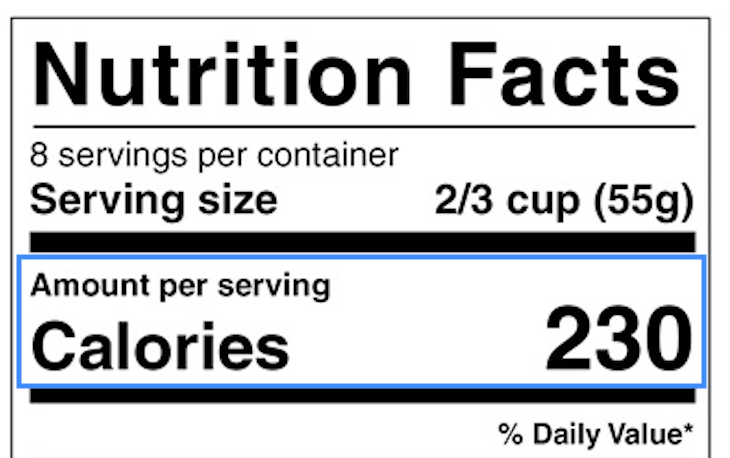
Carbs are measured in grams. On packaged foods, you can find total carb grams on the Nutrition Facts label. You can also check this list or use a carb-counting app such as CalorieKing or MyFitnessPal to find grams of carbs in foods and drinks.
Protein in Meals
Protein is one of three essential macronutrients; the other two are fat and carbohydrate. The body uses protein to build, repair, and maintain most of your body's tissues and organs. Proteins are also necessary for immune system function and they help some additional physiological processes.

According to the USDA Dietary Guidelines, it is recommended to eat 5 1/2 ounces of protein-rich food each day. Foods that are high in protein include meat, fish, seafood, chicken, eggs, dairy products, legumes, nuts, and seeds. For example, one-half chicken breast has 29 grams of protein. source
Fat in Meals
Fats are also an important part of a balanced diet. Since fats are higher in calories per gram (X calories
per gram), when it comes to fat, the key is being mindful of portions.
The American Diabetes Association and the National Academy of Medicine's guidelines indicate that 20 to 35
percent of total calories should come from fat.
Unlike protein, the effect of fat on blood glucose is not debated: the ingestion of fat delays stomach
emptying and increases insulin resistance, which ultimately results in a late rise in blood glucose. Further,
these effects may last for several hours after eating.
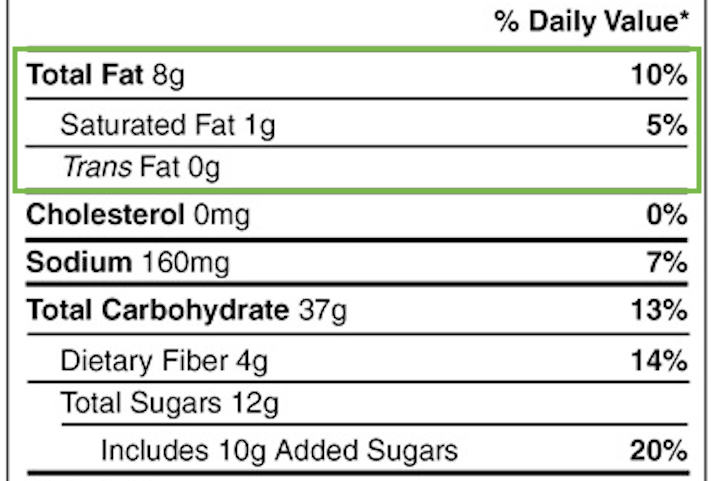
Total fat tells you how much fat is in one serving of the food. In general when it comes to fat, try to replace foods high in saturated fat or trans fat with foods rich in monounsaturated and polyunsaturated fats to reduce your risk of heart disease. source
What is Insulin?
Insulin is a hormone made by your body. Without insulin or enough insulin, your body is not able to use sugar (glucose) from the food that you eat to create energy, or to store glucose for future use.
Why is Insulin Important?
Insulin helps keep your blood glucose level from getting too high(hyperglycemia). Prolonged hyperglycemia can cause the complications we want to avoid. People with type 1 diabetes need to take insulin everyday in order to remain healthy. People with type 2 diabetes may also need to take insulin to control blood glucose levels.
Types of Insulin
There are four main types of insulin. Each type acts differently in the body:
- rapid-acting
- short-acting
- intermediate-acting
- long-acting
Each type has a different:
- Onset: how quickly it starts working after injection
- Peak: when it works most effectively, and
- Duration: how long it works in your body
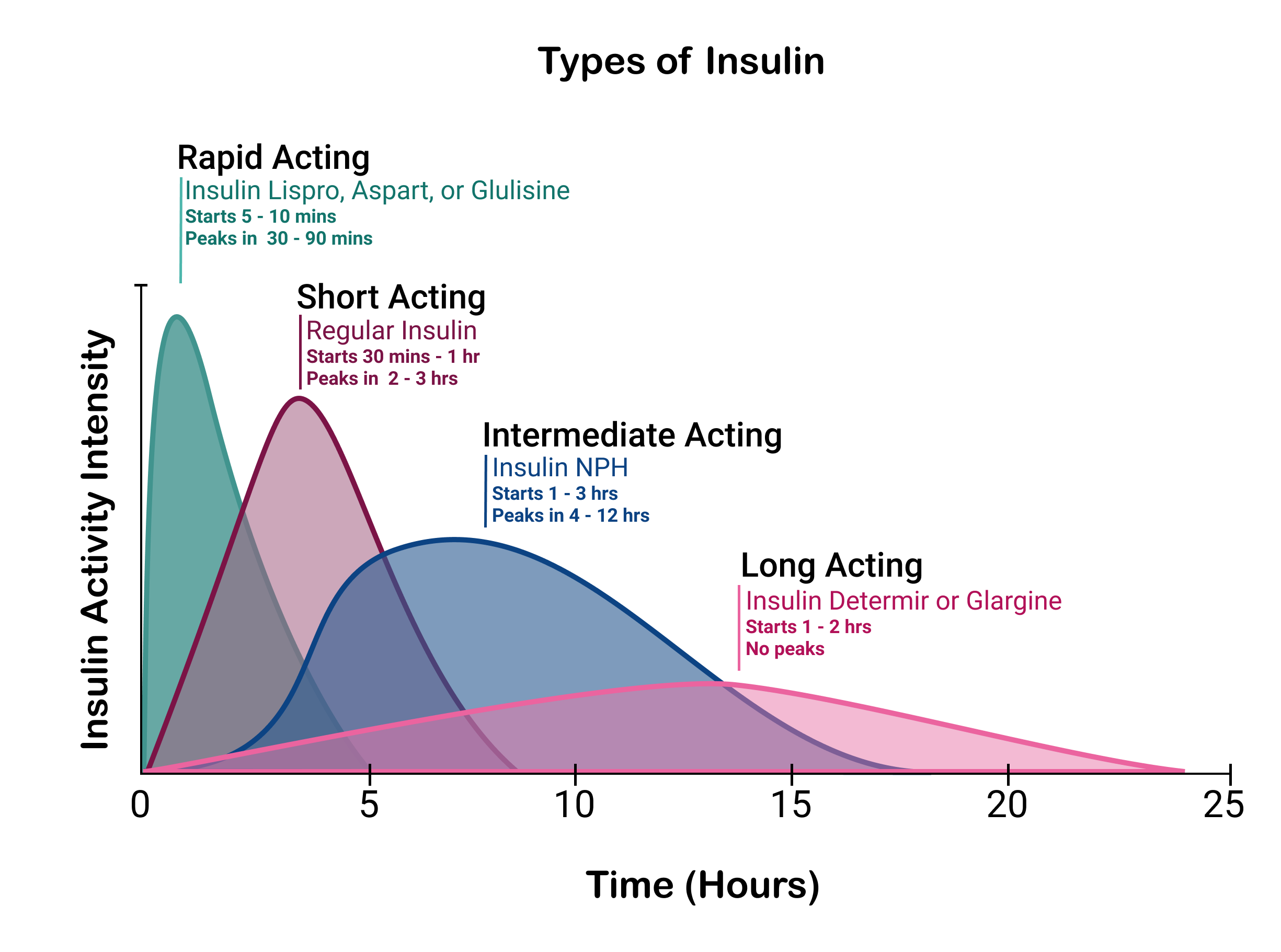
Bolus insulin (rapid- and short-acting insulin): These insulins work quickly and have a shorter duration compared to other insulins. These insulins are used to control blood glucose levels at meal time.
Basal insulin (intermediate-acting and long-acting): These insulins work more slowly and last longer; they provide “background” action to help keep blood glucose levels from going too high throughout the day and at night.
Note: Basal insulin is usually taken as a shot. However if you are on a pump, your basal insulin would be rapid-acting insulin given in small amounts throughout the day.
Our goal is to show how insulin dosing and timing for meals is important.
We will focus on rapid-acting insulin which is usually taken at meal times.
Insulin Activity Curve
The insulin activity curve shows when the insulin is working over time. It's important for understanding when to take insulin to best manage your blood glucose levels at meal time.
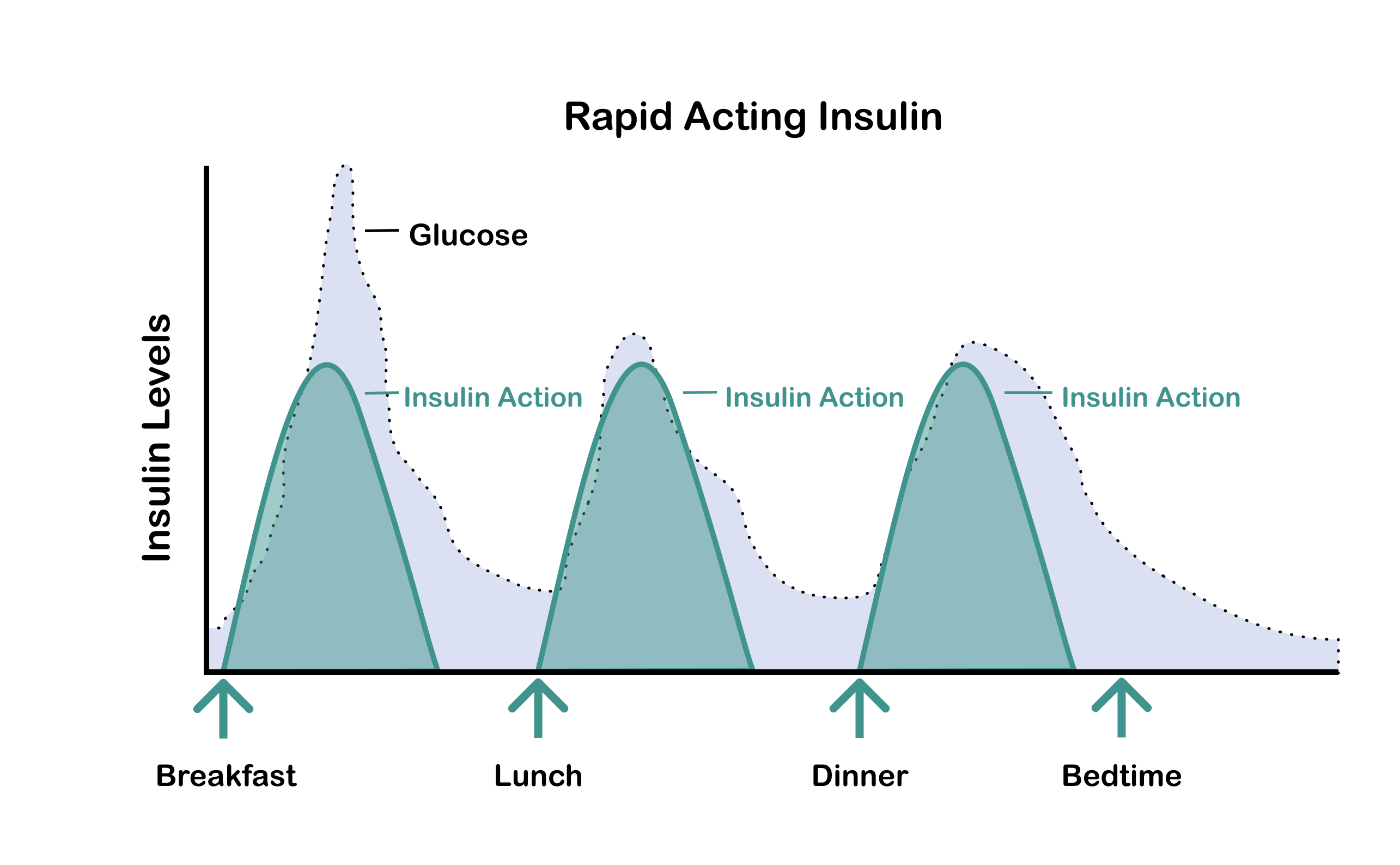
Rapid-acting insulin typically begins working about 5 - 20 minutes after it is taken, peaks within about 30 - 90 minutes, and is active in the bloodstream for about 3.5-5 hours.
Because rapid-acting insulin works more quickly, peaks higher and action time is shorter, it prevents blood glucose from going high at meal time.
Disclaimer: Rapid-acting insulin works differently for everyone, so your activity curve may vary. Please refer to your healthcare provider for more information.
Bolus Timing
A bolus is the dose of insulin you take when you eat to keep blood sugar levels controlled at meal time. Your bolus needs to act quickly to balance out the carbohydrates raising your blood sugar, so rapid-acting or short-acting insulin is typically used.
Pre-bolusing is the term used to describe taking your rapid-acting insulin dose before you eat, usually 15-20 minutes before depending on the circumstances. Pre-bolusing gives your insulin time to be absorbed in your body so that when you start eating, it’s ready to lower your blood glucose level.
Your health care provider will help you figure out when you should bolus. In some situations, taking insulin during or following a meal may be recommended. Talk to your doctor about what works best for you.
Disclaimer: There are many other factors that also affect glucose levels, such as exercising, type of food, illness, stress and medication. However, the focus for this tool is insulin.
See how different bolus time affects your blood glucose
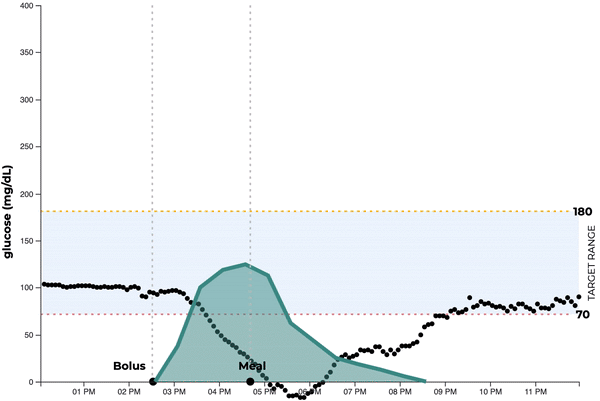
Bolus Dosing
Different foods will affect your blood glucose levels differently, so your bolus dose needs be matched to what you're eating. Learning how to count carbohydrates (which raise your blood glucose) can help you figure out how much insulin to take to keep your blood glucose in range at meal time.
For this tool, we use a typical American meal as a standard meal (about 45-75 grams of carbohydrates). Different people will require different amounts of carbohydrates and insulin.
Disclaimer: The numbers used in this tool are for education purposes only. Please ask your healthcare provider for more information.
See how different bolus dose affects your blood glucose
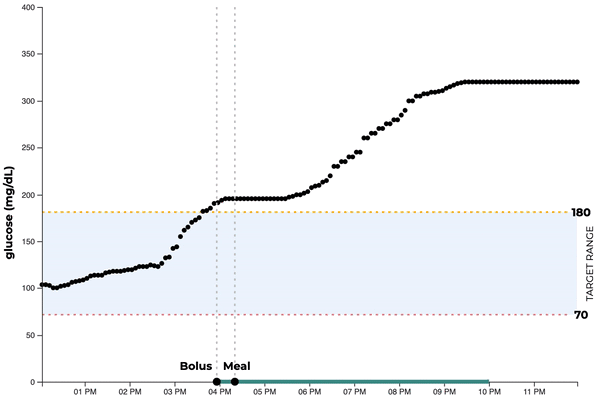
Time In Range
Time-in-Range is the percentage of time your blood sugar levels are within a target range. Our tool features a target range of 70 to 180 mg/dL, the recommended time-in-range by American Diabetes Association (ADA).
The goal is for people with a continuous glucose monitor (CGM) to increase time spent in-range, while reducing the time spent below or above target range The ADA recommendation is to spend at least 70% of the day in the target range of 70 to 180 mg/dL. Time-in-range is a useful way to track your progress and to provide insights into what behaviors and choices affect your glucose values. Time-in-range goals vary; talk to your healthcare provider.
Disclaimer: Your blood sugar targets may be different depending on your age, any additional health problems you have, and other factors. Be sure to talk to your health care team about which targets are best for you.

